-
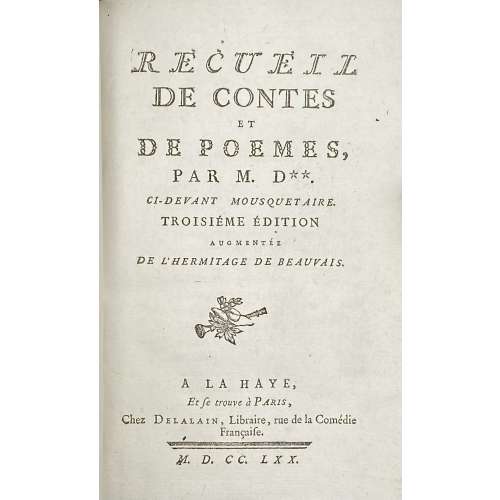 Title page: RECUEIL | DE CONTES | ET | DE POEMES, | PAR M. D**. | CI-DEVANT MOUSQUETAIRE. | TROSIÉME ÉDITION | AUGUMENTÉE | DE L'HERMITAGE DE BEAUVAIS. | [device] | A LA HAYE, | Et se trouve à Paris, | Chez Delalain, Libraire, rue de la Comédie | Française. | — | M. D. CC. LXX. IRZA | ET MARSIS , | POËME, includes: L'isle merveilleuse, Poëme, Chant 1re et Chant 2nd, Invocation a La Fontaine, and Alphonse, Conte – Cohen and De Ricci (#317) describe 2nd edition by the same publisher, 1769, 77 p., with similar illustrations after Charles Eisen: (1) engraved title by Louis Claude Legrand (2) L’Isle 1er: Frontispiece by Joseph de Longueil, (3) headpiece and (4) tailpiece by Emmanuel de Ghendt, and (5) L’Isle 2nd: Frontispiece by Jean Massard, (6) headpiece by Emmanuel de Ghendt + (7) tailpiece unsigned. Les Cerises et la Méprise, Contes en vers – Cohen and De Ricci (#311) also describe the 2nd edition of 1769, with the same (8) frontispiece by De Longueil after Eisen. Sélim et Sélima, Poeme imité de l'allemand; L'hermitage de beauvais, Conte –Cohen and De Ricci (#322) describe edition of 1769 by Sébastien Jorry, with the same (9) frontispiece by Emmanuel de Ghendt after Eisen. Size: 18.6 x 12.3 cm, small 8vo. Binding: polished, multi-coloured stained calf with gilt triple fillet border to boards; gilt floral arabesque and gilt lettering to flat spine: "Oeuvres de Dorat | Contes"; all edges gilt; blue-and-white marbled endpapers. Pagination: ffl, [2] IRZA ET MARSIS engraved half-title / blank, [1-2] - RECUEIL title page / blank, 3-8 (avis sur cette édition); [1 - L'Isle...] 2-184, bfl; Illustrations (copperplate engravings): 5 plates, 2 headpieces and 2 tailpieces. Collation: Octavo; a8 (title and avis sur cette édition); A-L8, M4. Author of the text: Claude Joseph Dorat, (French, 1734 – 1780) Artist: Charles-Dominique-JosephEisen (French, 1720 – 1778) Engravers: Emmanuel Jean Nepomucène de Ghendt (French, 1738 – 1815) Louis Claude Legrand (French, 1723 – 1807) Joseph de Longueil (French, 1730 – 1792) Jean Massard (French, 1740 – 1822)
Title page: RECUEIL | DE CONTES | ET | DE POEMES, | PAR M. D**. | CI-DEVANT MOUSQUETAIRE. | TROSIÉME ÉDITION | AUGUMENTÉE | DE L'HERMITAGE DE BEAUVAIS. | [device] | A LA HAYE, | Et se trouve à Paris, | Chez Delalain, Libraire, rue de la Comédie | Française. | — | M. D. CC. LXX. IRZA | ET MARSIS , | POËME, includes: L'isle merveilleuse, Poëme, Chant 1re et Chant 2nd, Invocation a La Fontaine, and Alphonse, Conte – Cohen and De Ricci (#317) describe 2nd edition by the same publisher, 1769, 77 p., with similar illustrations after Charles Eisen: (1) engraved title by Louis Claude Legrand (2) L’Isle 1er: Frontispiece by Joseph de Longueil, (3) headpiece and (4) tailpiece by Emmanuel de Ghendt, and (5) L’Isle 2nd: Frontispiece by Jean Massard, (6) headpiece by Emmanuel de Ghendt + (7) tailpiece unsigned. Les Cerises et la Méprise, Contes en vers – Cohen and De Ricci (#311) also describe the 2nd edition of 1769, with the same (8) frontispiece by De Longueil after Eisen. Sélim et Sélima, Poeme imité de l'allemand; L'hermitage de beauvais, Conte –Cohen and De Ricci (#322) describe edition of 1769 by Sébastien Jorry, with the same (9) frontispiece by Emmanuel de Ghendt after Eisen. Size: 18.6 x 12.3 cm, small 8vo. Binding: polished, multi-coloured stained calf with gilt triple fillet border to boards; gilt floral arabesque and gilt lettering to flat spine: "Oeuvres de Dorat | Contes"; all edges gilt; blue-and-white marbled endpapers. Pagination: ffl, [2] IRZA ET MARSIS engraved half-title / blank, [1-2] - RECUEIL title page / blank, 3-8 (avis sur cette édition); [1 - L'Isle...] 2-184, bfl; Illustrations (copperplate engravings): 5 plates, 2 headpieces and 2 tailpieces. Collation: Octavo; a8 (title and avis sur cette édition); A-L8, M4. Author of the text: Claude Joseph Dorat, (French, 1734 – 1780) Artist: Charles-Dominique-JosephEisen (French, 1720 – 1778) Engravers: Emmanuel Jean Nepomucène de Ghendt (French, 1738 – 1815) Louis Claude Legrand (French, 1723 – 1807) Joseph de Longueil (French, 1730 – 1792) Jean Massard (French, 1740 – 1822) -
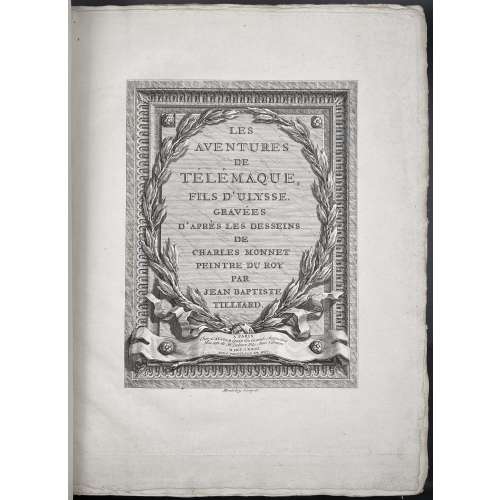 Vol. 1: Title page: LES AVENTURES | DE | TÉLÉMAQUE, | PAR FÉNELON. — | TOME PREMIER. | {publisher’s arms by Beugnet after Choffard} | DE L'IMPRIMERIE DE MONSIEUR. | M. DCC. LXXXV. || Title-frontispiece (engraved by Montulay): lettering within garland: Les Aventures de Télémaque, FILS D’ULYSSE. GRAVÉES | D’APRÈS LES DESSEINS | DE | CHARLES MONNET | PEINTRE DU ROY | PAR | JEAN BAPTISTE | TILLIARD. ||; Lettering on ribbon beneath the garland: A PARIS | Chez L’AUTEUR Quay des Grands Augustins | Maison de Mr. Debure Fils Aîné Libraire. M. DCC. LXXIII. | AVEC PRIVILEGE DU ROY. ||; Signed under the frame: Montulay Sculpsit. || Pagination: [2] – h.t. / imprint, [2] – t.p. / blank, [2] Advert., [2] d.t.p. / sommaire, [1] 2-309 [3 blanks], total 320 pages on thick wove paper plus engraved title-frontis. by Montulay, 12 engraved text leaves (one for each book), unsigned, and 36 plates (all in ornamental frame of laurel ribbon) by Tilliard after Monnet, all engravings on laid paper. Collation: 4to; vergé flyleaves at front and back, π4 A-2P4 plus 4 additional divisional titles in choirs C, F, I, and M for books 2-5, total 160 leaves, plus 49 plates. Vol. 2: Title page: Same but “TOME SECOND”. Pagination: [2] – h.t. / imprint, [2] – t.p. / blank, [1-3] 4-297 [298 blank] [2] – approb., total 304 pages plus 12 engraved text leaves (one for each book), and 36 plates, last 6 plates in a simple frame without the laurel ribbon and before signatures. Collation: 4to; π2 A-2O4 2P1 χ1, total 152 leaves, plus 48 plates. Binding: Two volumes uniformly bound in green paper boards with two red labels lettered in gilt, untrimmed. Size: overall 36.5 x 28 cm, platemark 32 x 25 cm, with white vergé flyleaves to front and back, similar pastedowns. Catalogue raisonné: Cohen, de Ricci (1912): 384-386; Ray (French): № 37, p. 74; Lewine (1898): p. 181. Contributors: François Fénelon [François de Salignac de la Mothe-Fénelon] (French, 1651 – 1715) – author. Choffard, Pierre Philippe (French, 1730 – 1809) – artist. Monnet, Charles (French, 1732 – after 1808) – artist. Montulay (French, fl. c. 1773) – engraver. Tilliard, Jean Baptiste (French, 1740 – 1813) – engraver. Beugnet, Jean (French, c. 1803) – engraver. Didot, Pierre-François (French, 1731 – 1795) – printer. Barrois, Louis-François (French, 1748 – 1835?); Barrois, Pierre-Théophile (French, 1752 – 1836); Onfroy, Eugène (French, before 1765 – 1809) ; Delalain, Louis-Alexandre (French, 1749? – 1798) – booksellers.
Vol. 1: Title page: LES AVENTURES | DE | TÉLÉMAQUE, | PAR FÉNELON. — | TOME PREMIER. | {publisher’s arms by Beugnet after Choffard} | DE L'IMPRIMERIE DE MONSIEUR. | M. DCC. LXXXV. || Title-frontispiece (engraved by Montulay): lettering within garland: Les Aventures de Télémaque, FILS D’ULYSSE. GRAVÉES | D’APRÈS LES DESSEINS | DE | CHARLES MONNET | PEINTRE DU ROY | PAR | JEAN BAPTISTE | TILLIARD. ||; Lettering on ribbon beneath the garland: A PARIS | Chez L’AUTEUR Quay des Grands Augustins | Maison de Mr. Debure Fils Aîné Libraire. M. DCC. LXXIII. | AVEC PRIVILEGE DU ROY. ||; Signed under the frame: Montulay Sculpsit. || Pagination: [2] – h.t. / imprint, [2] – t.p. / blank, [2] Advert., [2] d.t.p. / sommaire, [1] 2-309 [3 blanks], total 320 pages on thick wove paper plus engraved title-frontis. by Montulay, 12 engraved text leaves (one for each book), unsigned, and 36 plates (all in ornamental frame of laurel ribbon) by Tilliard after Monnet, all engravings on laid paper. Collation: 4to; vergé flyleaves at front and back, π4 A-2P4 plus 4 additional divisional titles in choirs C, F, I, and M for books 2-5, total 160 leaves, plus 49 plates. Vol. 2: Title page: Same but “TOME SECOND”. Pagination: [2] – h.t. / imprint, [2] – t.p. / blank, [1-3] 4-297 [298 blank] [2] – approb., total 304 pages plus 12 engraved text leaves (one for each book), and 36 plates, last 6 plates in a simple frame without the laurel ribbon and before signatures. Collation: 4to; π2 A-2O4 2P1 χ1, total 152 leaves, plus 48 plates. Binding: Two volumes uniformly bound in green paper boards with two red labels lettered in gilt, untrimmed. Size: overall 36.5 x 28 cm, platemark 32 x 25 cm, with white vergé flyleaves to front and back, similar pastedowns. Catalogue raisonné: Cohen, de Ricci (1912): 384-386; Ray (French): № 37, p. 74; Lewine (1898): p. 181. Contributors: François Fénelon [François de Salignac de la Mothe-Fénelon] (French, 1651 – 1715) – author. Choffard, Pierre Philippe (French, 1730 – 1809) – artist. Monnet, Charles (French, 1732 – after 1808) – artist. Montulay (French, fl. c. 1773) – engraver. Tilliard, Jean Baptiste (French, 1740 – 1813) – engraver. Beugnet, Jean (French, c. 1803) – engraver. Didot, Pierre-François (French, 1731 – 1795) – printer. Barrois, Louis-François (French, 1748 – 1835?); Barrois, Pierre-Théophile (French, 1752 – 1836); Onfroy, Eugène (French, before 1765 – 1809) ; Delalain, Louis-Alexandre (French, 1749? – 1798) – booksellers. -
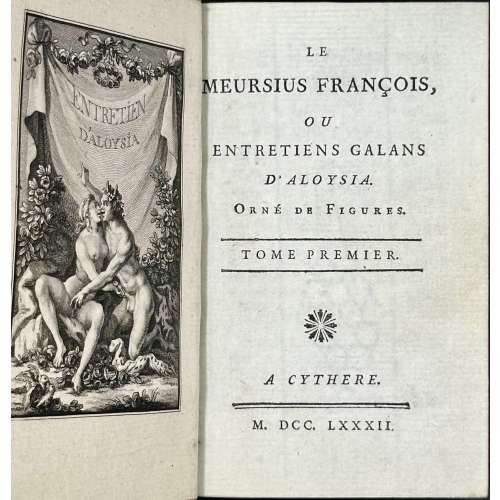 Hardcover volume, 12mo, 125 x 85 mm, two parts in one, bound and gilded by Cuzin and Maillard, respectively, between 1876 and 1881, in crimson crushed morocco with raised bands and gilt lettering to spine, marbled endpapers, all edges gilt, gilt dentelle, signed 'Cuzin' to foot of front turn-in and 'Maillard dor.' to rear. Adorned with engraved frontispiece and 12 plates by Elluin after Borel. Text printed on a slightly bluish paper. Title-page: LE | MEURSIUS FRANÇOIS, | OU | ENTRETIENS GALANS | D'ALOYSIA. | ORNÉ | DE FIGURES. | — | TOME PREMIER (SECOND) | — | ✵ | A CYTHERE | — | M. DCC. LXXXII. || Collation: 12mo, π4 (2 blanks) A-Z6 χ1,+ π2 A-S6 (4 blanks) χ1, total 254 leaves; pagination: [8] [1] 2-277 [278 blank], [4] [1] 2-210 [8 blanks], total 508 pages, plus 13 engraved plates, incl. frontispiece. Catalogue raisonné: Cohen-de Ricci 240; Eros invaincu 17; Fekete 51; Nordmann (I) 91. Contributors: Nicolas Chorier (French, 1612 – 1692) – author. Antoine Borel (French, 1743 – 1810) – artist. François-Rolland Elluin (French, 1745 – c. 1822) – engraver. Hubert-Martin Cazin (French, 1724 – 1795) – publisher. Francisque Cuzin (French, 1836 – 1890) – bookbinder. Seller’s description: Erotica.- [Chorier (Nicolas)]Le Meursius François, ou Entretiens galans d'Aloysia, 2 parts in 1, half-title to each part, engraved frontispiece and 12 plates [by Elluin after Borel], handsomely bound in crimson crushed morocco by Cuzin, spine with gilt lettering and five raised bands, gilt tooled turn-ins by Maillard, signed 'Cuzin' to foot of front turn-in and 'Maillard dor.' to rear, marbled endpapers, g.e., fractional rubbing to extremities, an excellent copy, 12mo, Cythere [but Paris], [Cazin], 1782.
Hardcover volume, 12mo, 125 x 85 mm, two parts in one, bound and gilded by Cuzin and Maillard, respectively, between 1876 and 1881, in crimson crushed morocco with raised bands and gilt lettering to spine, marbled endpapers, all edges gilt, gilt dentelle, signed 'Cuzin' to foot of front turn-in and 'Maillard dor.' to rear. Adorned with engraved frontispiece and 12 plates by Elluin after Borel. Text printed on a slightly bluish paper. Title-page: LE | MEURSIUS FRANÇOIS, | OU | ENTRETIENS GALANS | D'ALOYSIA. | ORNÉ | DE FIGURES. | — | TOME PREMIER (SECOND) | — | ✵ | A CYTHERE | — | M. DCC. LXXXII. || Collation: 12mo, π4 (2 blanks) A-Z6 χ1,+ π2 A-S6 (4 blanks) χ1, total 254 leaves; pagination: [8] [1] 2-277 [278 blank], [4] [1] 2-210 [8 blanks], total 508 pages, plus 13 engraved plates, incl. frontispiece. Catalogue raisonné: Cohen-de Ricci 240; Eros invaincu 17; Fekete 51; Nordmann (I) 91. Contributors: Nicolas Chorier (French, 1612 – 1692) – author. Antoine Borel (French, 1743 – 1810) – artist. François-Rolland Elluin (French, 1745 – c. 1822) – engraver. Hubert-Martin Cazin (French, 1724 – 1795) – publisher. Francisque Cuzin (French, 1836 – 1890) – bookbinder. Seller’s description: Erotica.- [Chorier (Nicolas)]Le Meursius François, ou Entretiens galans d'Aloysia, 2 parts in 1, half-title to each part, engraved frontispiece and 12 plates [by Elluin after Borel], handsomely bound in crimson crushed morocco by Cuzin, spine with gilt lettering and five raised bands, gilt tooled turn-ins by Maillard, signed 'Cuzin' to foot of front turn-in and 'Maillard dor.' to rear, marbled endpapers, g.e., fractional rubbing to extremities, an excellent copy, 12mo, Cythere [but Paris], [Cazin], 1782. -
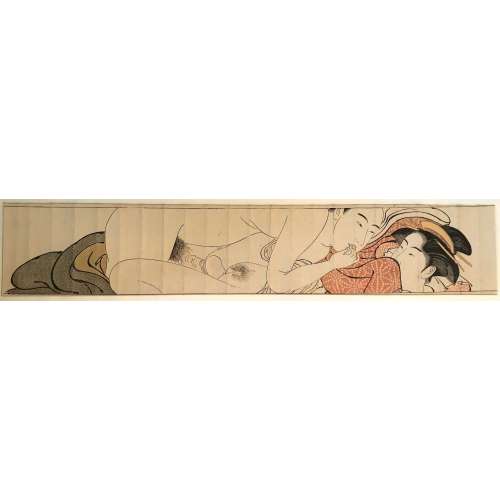 Artist: Torii Kiyonaga [鳥居 清長] (Japanese, 1752 – 1815) Color woodblock print: makimono-e (11.4 x 65.4 cm). Year: c. 1785. Three sheets of the series of twelve, № 6, № 9, and № 11, "from Kiyonaga's most idiosyncratic and celebrated series of pornography. It was designed as part of a miniature handscroll (makimono) to place in one's sleeve, where it was carried both for its stimulatory and for its talismanic properties." [LIB-1474.2018] Important Japanese prints from the collection of Henry Steiner by Sebastian Izzard.]№ 6: "The woman's blackened teeth indicate that she is a wife. This middle-aged couple is relaxing and drowsing after lovemaking. The scene is peaceful now., but the pillow cast aside hints at their earlier, passionate lovemaking".
Artist: Torii Kiyonaga [鳥居 清長] (Japanese, 1752 – 1815) Color woodblock print: makimono-e (11.4 x 65.4 cm). Year: c. 1785. Three sheets of the series of twelve, № 6, № 9, and № 11, "from Kiyonaga's most idiosyncratic and celebrated series of pornography. It was designed as part of a miniature handscroll (makimono) to place in one's sleeve, where it was carried both for its stimulatory and for its talismanic properties." [LIB-1474.2018] Important Japanese prints from the collection of Henry Steiner by Sebastian Izzard.]№ 6: "The woman's blackened teeth indicate that she is a wife. This middle-aged couple is relaxing and drowsing after lovemaking. The scene is peaceful now., but the pillow cast aside hints at their earlier, passionate lovemaking".
Picture № 6. (31d in LIB-2971.2022)
№ 9: "This looks to be the first sexual experience of a young woman of a well-to-do family, who covers her mouth shyly. The more experienced man moistens his fingers with saliva, eager to explore the young woman's body".
Picture № 9.
№ 11: "The woman wears a so-called Iwata sash signalling that she is pregnant. The man approaches from behind so as not to put pressure on her stomach. He shows care and gentle consideration toward his pregnant wife, who appears relaxed". Picture descriptions from Shunga: Sex and Pleasure in Japanese art. Edited by Timothy Clark, C. Andrew Gerstle, Aki Ishigami, Akiki Yano. Hotei Publishing, 2013. Ref.: [LIB-2971.2022] Chris Uhlenbeck, Margarita Winkel. Japanese erotic fantasies sexual imagery of the Edo period. — Amsterdam: Hotei Publishing, ©2005; p. 118-9 (№ 31).
Picture № 11. (31g in LIB-2971.2022)
-
 Katsukawa Shun'ei (勝川 春英; 1762 – 1819).TITLE: Sawamura Sôjûrô III as Kakogawa Honzô.SERIES: Kanadehon Chūshingura (Kana practice book: Treasury of the loyal retainers").DATE: 1795Signed: Shun'ei ga (春英画). Publisher: Iwatoya Kisaburō, Marks 173/p.169. Vertical Ōban: 14.75 x 9.625 inchOn 4th lunar month of 1795 Sôjûrô plays the roles of En'ya Hangan and Kakogawa Honzô in the drama "Kanadehon Chûshingura" at Miyakoza theater in Edo.
Katsukawa Shun'ei (勝川 春英; 1762 – 1819).TITLE: Sawamura Sôjûrô III as Kakogawa Honzô.SERIES: Kanadehon Chūshingura (Kana practice book: Treasury of the loyal retainers").DATE: 1795Signed: Shun'ei ga (春英画). Publisher: Iwatoya Kisaburō, Marks 173/p.169. Vertical Ōban: 14.75 x 9.625 inchOn 4th lunar month of 1795 Sôjûrô plays the roles of En'ya Hangan and Kakogawa Honzô in the drama "Kanadehon Chûshingura" at Miyakoza theater in Edo. -
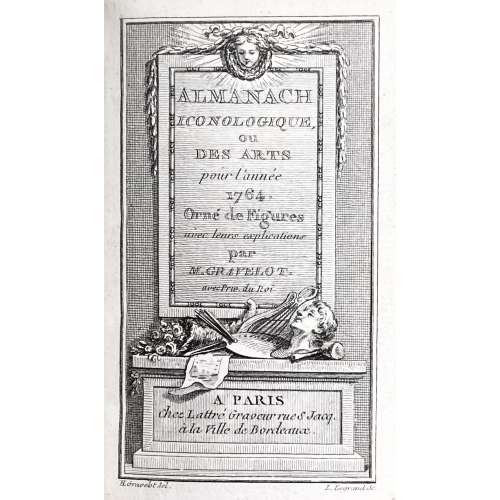
Engraved title:
Upper frame: ALMANACH | ICONOLOGIQUE, | OU | DES ARTS | pour l'année | 1764. | Orné de Figures | avec leurs explications | par | M. GRAVELOT. | avec Priv. du Roy | A PARIS
Lower frame: Chez Lattré Graveur rue S. Jacq. | à la Ville de Bordeaux.
Under the frame: H. Gravelot del. — L. Legrand sc.
28 leaves, of them: engraved t.p., engraved frontis., and 12 plates, text engraved. Pages numbered 1-12, and I-XII (incorrectly marked XVI), other unpaginated, unbound tissue guards. Size: 10.6 x 7.2 cm, full polished crimson calf w/veins, triple-ruled in gilt with florets in corners, flat spine, double-ruled in gilt, all edges gilt. Florets in compartments, black title label with gilt lettering “ALM | ICON ||”, peacock marbled endpapers, blue silk ribbon. Approbation dated 15 November 1763, as some plates.
Catalogue raisonné: Cohen, De Ricci 454.
-
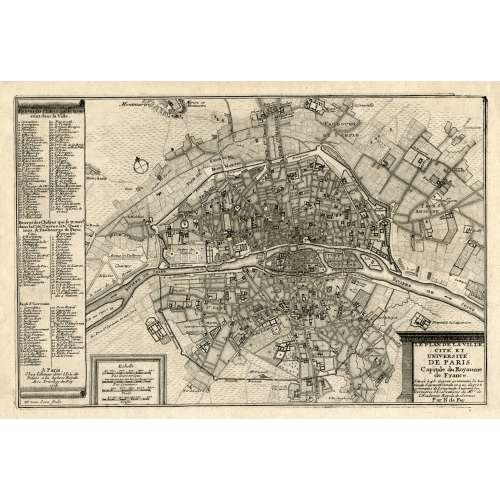 LE PLAN DE LA VILLE, | CITE, ET | UNIVERSITÉ | DE PARIS. | Capitale du Royaume | de France. | {5 lines in italic} | Par N. de Fer. | A Paris, | Chez l’Auteur dans l’Isle du | Palais a la Sphere Royale. | Avec Privilege du Roy. | 1705 | H. van Loon sculp. || Dimensions: Sheet: 27 x 39 cm; Image: 22 x 33 cm. Contributors: Nicolas de Fer (French, 1646 – 1720) – cartographer. Harmanus van Loon (Flemish, fl. c. 1690 – c. 1725) – engraver.
LE PLAN DE LA VILLE, | CITE, ET | UNIVERSITÉ | DE PARIS. | Capitale du Royaume | de France. | {5 lines in italic} | Par N. de Fer. | A Paris, | Chez l’Auteur dans l’Isle du | Palais a la Sphere Royale. | Avec Privilege du Roy. | 1705 | H. van Loon sculp. || Dimensions: Sheet: 27 x 39 cm; Image: 22 x 33 cm. Contributors: Nicolas de Fer (French, 1646 – 1720) – cartographer. Harmanus van Loon (Flemish, fl. c. 1690 – c. 1725) – engraver. -
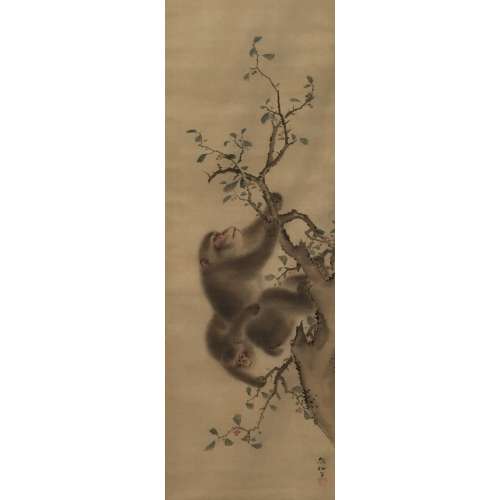 Mori Sosen (1747-1821). Two Monkeys Hanging From Branches. Hanging Scroll Painting. Ink and colour on silk. Signed: Sosen. Sealed: Sosen.
Mori Sosen (1747-1821). Two Monkeys Hanging From Branches. Hanging Scroll Painting. Ink and colour on silk. Signed: Sosen. Sealed: Sosen. -
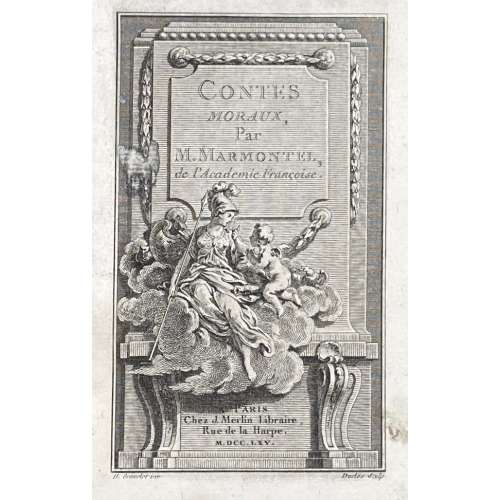 Engraved title-page: Contes | Moraux | Par | M. Marmontel, | de l'Academie Françoise. | A Paris | Chez J. Merlin Libraire, | Rue de la Harpe, | M DCC LXV ||Description: 3 volumes, 8vo, 20.4 x 13 cm, first issue, bound in the contemporary speckled calf, all edges gilt, spines gilt with double red/brown lettering labels (vol 1. labels missing); raised bands, gilt in compartments, double gilt-ruled borders; marbled endpapers. With the contemporary signature in each volume of Caroline Marlborough of Blenheim Palace, and bookplates of Lord F. A. Spencer. This is certainly Lady Caroline Russell, wife of George Spencer, Fourth Duke of Marlborough; she was daughter to the Duke of Bedford and was married in 1762. She died at Blenheim in 1811. The later bookplate in each volume pasted to the front pastedown of her son Francis Almeric Spencer (British, 1779-1845). Pagination: Vol. I: [two blank leaves] [half-title, verso blank] [recto blank, frontispiece on verso: portrait of Marmontel by St. Aubin after Cochin] [engraved t.p. by Duclos after Gravelot, verso blank], [i] ii-xvi, [table des contes with 5-line Errata (autograph Lordine Marlborough), verso blank], [1] 2–345 [346-50 blanks]; 9 plates after Gravelot by: Baquoy, de Longueil (2), Legrand, Leveau (2), Rousseau, Voyez, and unsigned (1). Vol. 2: [two blank leaves] [half-title, verso blank] [engraved t.p. by Duclos after Gravelot, verso blank] [table des contes with 10-line Errata (autograph Lordine Marlborough), verso blank], [1] 2–376 [377-50 blanks]; 9 plates after Gravelot by: de Longueil (5), Leveau (2), Pasquier and Rousseau. Vol. 3: [two blank leaves] [half-title, verso blank] [engraved t.p. by Duclos after Gravelot, verso blank] [table des contes with 9-line Errata, verso blank] [two leaves: approbation and Privilege du Roi] [1] 2–312 [313-16 blanks]; 5 plates after Gravelot by: de Longueil (2), Le Mire (2), and Pasquier. Catalogue raisonné: Cohen-De Ricci 686-7; Gordon N. Ray. The Art of the French Illustrated Book 1700 to 1914. — NY, London: The Pierpont Morgan Library; Cornell University Press, 1982, Vol. 1. pp. 44-5. [In their copy vol. 2 and 3 in a different order]; MFA ACCESSION NUMBER 37.1488a-c Illustrated by: Hubert François Gravelot (French, 1699–1773) Engraved by: Jean Charles Baquoy (French, 1721–1777) Engraved by: Antoine Jean Duclos (French, 1742–1795) Engraved by: Louis Legrand (French, 1723–1807) Engraved by: Noël Le Mire (French, 1724–1801) Engraved by: Jean Jacques André Le Veau (French, 1729–1785) Engraved by: Joseph de Longueil (French, 1730–1792) Engraved by: Jean Jacques Pasquier (French, died in 1785) Engraved by: Jean François Rousseau (French, born in 1740) Engraved by: Nicolas Joseph Voyez l'ainé (French, 1742–1806) Portrait(s) designed by: Charles-Nicolas Cochin le fils (French, 1715–1790) Engraved by: Augustin de Saint-Aubin (French, 1736–1807) Author: Jean-François Marmontel (French, 1723–1799) Publisher: Joseph Merlin (French, 1718–1783) Printer: Pierre-Alexandre Le Prieur (French, born in 1722)
Engraved title-page: Contes | Moraux | Par | M. Marmontel, | de l'Academie Françoise. | A Paris | Chez J. Merlin Libraire, | Rue de la Harpe, | M DCC LXV ||Description: 3 volumes, 8vo, 20.4 x 13 cm, first issue, bound in the contemporary speckled calf, all edges gilt, spines gilt with double red/brown lettering labels (vol 1. labels missing); raised bands, gilt in compartments, double gilt-ruled borders; marbled endpapers. With the contemporary signature in each volume of Caroline Marlborough of Blenheim Palace, and bookplates of Lord F. A. Spencer. This is certainly Lady Caroline Russell, wife of George Spencer, Fourth Duke of Marlborough; she was daughter to the Duke of Bedford and was married in 1762. She died at Blenheim in 1811. The later bookplate in each volume pasted to the front pastedown of her son Francis Almeric Spencer (British, 1779-1845). Pagination: Vol. I: [two blank leaves] [half-title, verso blank] [recto blank, frontispiece on verso: portrait of Marmontel by St. Aubin after Cochin] [engraved t.p. by Duclos after Gravelot, verso blank], [i] ii-xvi, [table des contes with 5-line Errata (autograph Lordine Marlborough), verso blank], [1] 2–345 [346-50 blanks]; 9 plates after Gravelot by: Baquoy, de Longueil (2), Legrand, Leveau (2), Rousseau, Voyez, and unsigned (1). Vol. 2: [two blank leaves] [half-title, verso blank] [engraved t.p. by Duclos after Gravelot, verso blank] [table des contes with 10-line Errata (autograph Lordine Marlborough), verso blank], [1] 2–376 [377-50 blanks]; 9 plates after Gravelot by: de Longueil (5), Leveau (2), Pasquier and Rousseau. Vol. 3: [two blank leaves] [half-title, verso blank] [engraved t.p. by Duclos after Gravelot, verso blank] [table des contes with 9-line Errata, verso blank] [two leaves: approbation and Privilege du Roi] [1] 2–312 [313-16 blanks]; 5 plates after Gravelot by: de Longueil (2), Le Mire (2), and Pasquier. Catalogue raisonné: Cohen-De Ricci 686-7; Gordon N. Ray. The Art of the French Illustrated Book 1700 to 1914. — NY, London: The Pierpont Morgan Library; Cornell University Press, 1982, Vol. 1. pp. 44-5. [In their copy vol. 2 and 3 in a different order]; MFA ACCESSION NUMBER 37.1488a-c Illustrated by: Hubert François Gravelot (French, 1699–1773) Engraved by: Jean Charles Baquoy (French, 1721–1777) Engraved by: Antoine Jean Duclos (French, 1742–1795) Engraved by: Louis Legrand (French, 1723–1807) Engraved by: Noël Le Mire (French, 1724–1801) Engraved by: Jean Jacques André Le Veau (French, 1729–1785) Engraved by: Joseph de Longueil (French, 1730–1792) Engraved by: Jean Jacques Pasquier (French, died in 1785) Engraved by: Jean François Rousseau (French, born in 1740) Engraved by: Nicolas Joseph Voyez l'ainé (French, 1742–1806) Portrait(s) designed by: Charles-Nicolas Cochin le fils (French, 1715–1790) Engraved by: Augustin de Saint-Aubin (French, 1736–1807) Author: Jean-François Marmontel (French, 1723–1799) Publisher: Joseph Merlin (French, 1718–1783) Printer: Pierre-Alexandre Le Prieur (French, born in 1722) -
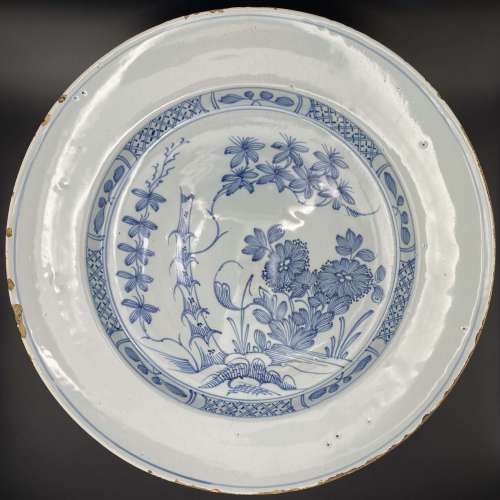 Round plate with a blue and white design of blossoming bamboo and chrysanthemums in the centre with a border of lattice and floral sprays. Diameter: 34 cm, Haight: 5.5 cm.
Round plate with a blue and white design of blossoming bamboo and chrysanthemums in the centre with a border of lattice and floral sprays. Diameter: 34 cm, Haight: 5.5 cm. -
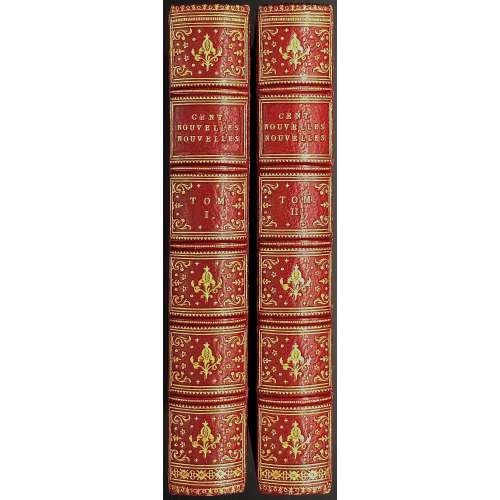 Description: Two volumes, 16.5 x 11 cm, collated 8vo, uniformly bound in the mid-19th century by H. Stamper (stamp to verso free endpaper) in red Morocco, ornated with gilt fillets and dentelles to boards and turn-ins, spine with raised bands and gilt decorations and lettering in compartments, marbled endpapers, all edges gilt; printed on laid paper; bookplate to front pastedown “EX LIBRIS | DANIEL | BERDITCHEVSKY”. Title-page (red and black, tall ‘s’): LES CENT | NOUVELLES | NOUVELLES. | SUIVENT LES CENT NOUVELLES | CONTENANT | Les Cent Histoires Nouveaux, | Qui sont moult plaisans a raconter, | En toutes bonnes Compagnies, | Par MANIERE DE JOYEUSETÉ. | Avec d'excellentes Figures en Taille-douce, | Gravées sur les desseins du fameux Mr. | ROMAIN DE HOOGE | & retouchées par feu | B. PICART LE ROMAIN | TOME PREMIER (TOME SECOND) |{device} | A COLOGNE | Chez Pierre Gaillard. | M.DCCXXXVI. || Vol. 1: Collation: [1] flyleaf torn out, [1] frontispiece, [1] title-page, [3] preface (*2-4), [1] Auertissement, [10] table (2+**-**8), A-Bb8 (Bb8 blank); 45 in-text half-page copperplate etchings by various engravers after Romain de Hooge; total 215 leaves plus ffl and frontispiece by Gilliam van der Gouwen after Romain de Hooge. Pagination (starting from t.p.): [30] 1-397 [398] [2], total 430 pages. Vol. 2: Collation: ffl, [*1] t.p., [11] table (*2-8, **-4), A-Aa8 Bb4 (Bb4 blank); 55 in-text half-page copperplate etchings by various engravers after Romain de Hooge; total 208 leaves plus ffl. Pagination: [24] 1-389 [390] [2], total 416 pages. Catalogue raisonné: Landwehr (1970) № 94, p. 203; Lewine (1898) p. 326; Cohen-DeRicci (1912) p. 658. Landwehr cites two editions after the 1st of 1701: Amsterdam 1732 and Cologne 1786 [i.e. 1736]. Both Lewine and Cohen-DeRicci attribute the text to Louis XI and mention the 1736 reprint (though not 1786). The first edition of “Les cent nouvelles nouvelles” appeared in 1486 by commission of Duke of Burgundy Philippe le Bon; the text is attributed to Philippe Pot (1428 – 1493), Antoine de La Sale (c. 1385 – c. 1460) or King Louis XI (1423 – 1483). Contributors: Artists: Romain de Hooge (Dutch, 1645 – 1708) Bernard Picart (French, 1673 – 1733) Engravers: Gilliam van der Gouwen (Dutch, c. 1657 – 1716) (frontispiece) Laurens Scherm (Dutch, fl. 1689 – 1701) (nouvelles XXIX, XXX, LXXVII) Jan Van Vianen (Dutch, c.1660 – 1726?) (nouvelles L, LII, LVII-LX, LXIV-LXVII, LXX) Binder: Henry Stamper (British, 1802? – 1887) Commissioner: Philippe le Bon [Philip III] (French, 1396 – 1467) Publisher: Pierre Gaillard (French, fl. 1715 – 1737)
Description: Two volumes, 16.5 x 11 cm, collated 8vo, uniformly bound in the mid-19th century by H. Stamper (stamp to verso free endpaper) in red Morocco, ornated with gilt fillets and dentelles to boards and turn-ins, spine with raised bands and gilt decorations and lettering in compartments, marbled endpapers, all edges gilt; printed on laid paper; bookplate to front pastedown “EX LIBRIS | DANIEL | BERDITCHEVSKY”. Title-page (red and black, tall ‘s’): LES CENT | NOUVELLES | NOUVELLES. | SUIVENT LES CENT NOUVELLES | CONTENANT | Les Cent Histoires Nouveaux, | Qui sont moult plaisans a raconter, | En toutes bonnes Compagnies, | Par MANIERE DE JOYEUSETÉ. | Avec d'excellentes Figures en Taille-douce, | Gravées sur les desseins du fameux Mr. | ROMAIN DE HOOGE | & retouchées par feu | B. PICART LE ROMAIN | TOME PREMIER (TOME SECOND) |{device} | A COLOGNE | Chez Pierre Gaillard. | M.DCCXXXVI. || Vol. 1: Collation: [1] flyleaf torn out, [1] frontispiece, [1] title-page, [3] preface (*2-4), [1] Auertissement, [10] table (2+**-**8), A-Bb8 (Bb8 blank); 45 in-text half-page copperplate etchings by various engravers after Romain de Hooge; total 215 leaves plus ffl and frontispiece by Gilliam van der Gouwen after Romain de Hooge. Pagination (starting from t.p.): [30] 1-397 [398] [2], total 430 pages. Vol. 2: Collation: ffl, [*1] t.p., [11] table (*2-8, **-4), A-Aa8 Bb4 (Bb4 blank); 55 in-text half-page copperplate etchings by various engravers after Romain de Hooge; total 208 leaves plus ffl. Pagination: [24] 1-389 [390] [2], total 416 pages. Catalogue raisonné: Landwehr (1970) № 94, p. 203; Lewine (1898) p. 326; Cohen-DeRicci (1912) p. 658. Landwehr cites two editions after the 1st of 1701: Amsterdam 1732 and Cologne 1786 [i.e. 1736]. Both Lewine and Cohen-DeRicci attribute the text to Louis XI and mention the 1736 reprint (though not 1786). The first edition of “Les cent nouvelles nouvelles” appeared in 1486 by commission of Duke of Burgundy Philippe le Bon; the text is attributed to Philippe Pot (1428 – 1493), Antoine de La Sale (c. 1385 – c. 1460) or King Louis XI (1423 – 1483). Contributors: Artists: Romain de Hooge (Dutch, 1645 – 1708) Bernard Picart (French, 1673 – 1733) Engravers: Gilliam van der Gouwen (Dutch, c. 1657 – 1716) (frontispiece) Laurens Scherm (Dutch, fl. 1689 – 1701) (nouvelles XXIX, XXX, LXXVII) Jan Van Vianen (Dutch, c.1660 – 1726?) (nouvelles L, LII, LVII-LX, LXIV-LXVII, LXX) Binder: Henry Stamper (British, 1802? – 1887) Commissioner: Philippe le Bon [Philip III] (French, 1396 – 1467) Publisher: Pierre Gaillard (French, fl. 1715 – 1737) -
 Shakudō tsuba of the slightly vertically elongated round form (nagamaru-gata) decorated by gold in flat inlay (hira-zōgan) with three insects (cricket, locust, and praying mantis), grass and dewdrops motif. Kogai hitsu-ana is plugged with gilded soft metal. Height: 70.2 mm; width: 66.4 mm x Thickness at seppa-dai: 4.5 mm. Edo period (from ca. 1700 to ca. 1850) Unsigned. Attributed to Kaga School or Murakami School. Almost identical tsuba (no dewdrops, though) is illustrated and described at page 60 of Kokusai Tosogu Kai. 7th International Convention & Exhibition, November 1st, 2011 at Tokyo National Museum, page 60. It is attributed to the Kaga School, Mid Edo period (Late 17th - early 18th century). Dimensions: 70.5 x 66 x 4.5 mm. "The rich black shakudo plate has been slightly lowered (dished out) and then polished. Gold insects crawl amongst grasses, depicted by Kaga style hirazogan (flat inlay). One tendril of the mantis overlaps onto seppa-dai. The mantis boldly looks out from the tsuba in a curious way. This style of Kaga tsuba was popular during the Genroku era (1688-1703)."Another source is Japanese Sword Fittings. A descriptive catalogue of the Collection of G.H. Naunton, Esq., completed and illustrated by Henri L. Joly, - 1912:
Shakudō tsuba of the slightly vertically elongated round form (nagamaru-gata) decorated by gold in flat inlay (hira-zōgan) with three insects (cricket, locust, and praying mantis), grass and dewdrops motif. Kogai hitsu-ana is plugged with gilded soft metal. Height: 70.2 mm; width: 66.4 mm x Thickness at seppa-dai: 4.5 mm. Edo period (from ca. 1700 to ca. 1850) Unsigned. Attributed to Kaga School or Murakami School. Almost identical tsuba (no dewdrops, though) is illustrated and described at page 60 of Kokusai Tosogu Kai. 7th International Convention & Exhibition, November 1st, 2011 at Tokyo National Museum, page 60. It is attributed to the Kaga School, Mid Edo period (Late 17th - early 18th century). Dimensions: 70.5 x 66 x 4.5 mm. "The rich black shakudo plate has been slightly lowered (dished out) and then polished. Gold insects crawl amongst grasses, depicted by Kaga style hirazogan (flat inlay). One tendril of the mantis overlaps onto seppa-dai. The mantis boldly looks out from the tsuba in a curious way. This style of Kaga tsuba was popular during the Genroku era (1688-1703)."Another source is Japanese Sword Fittings. A descriptive catalogue of the Collection of G.H. Naunton, Esq., completed and illustrated by Henri L. Joly, - 1912:
7-U17. Ron Hartmann Collection.
Kanazawa in Kaga was a centre of fine metal work during the whole of the Tokugawa period. At first the inlayers of Fushimi following the Daimyo Maeda went to Kanazawa, then some of the Gotō masters proceeded from Kyoto for short periods to work for the Daimyo, so that their influence was strongly impressed upon Kaga work..." A somewhat look-a-like tsuba is illustrated at plate XXVIII, Kaga Inlay, №653 with the following description at page 52: "Shakudō, inlaid with five insects in gold: crickets, praying mantis, grasshopper, in the style of Takagawara Ujitsugu.
According to M. Sesko, Ujitsugu was a master from Katsuki and Kaneko School in Kaga, son of Ujihira. Ujihira's father Ujiyoshi died in 1802. This brings us to the mid-19th century, instead of mid-18th or earlier. On the other hand, a very much look alike specimen at MFA collection (ACCESSION NUMBER 17.1061) has the with the following description: Edo period. Late 18th–early 19th century. Murakami School. Main material: shakudo; other metals: gold; decorative technique: iroe hirazogan.A detailed account of Murakami school can be found at The Japanese toso-kinko Schools.// Lulu Inc., 2012 by Markus Sesko, on pages 235-239. All-in-all, it's either Kaga School or Murakami School, either ca. 1700 or ca. 1850. Quite a range! SOLD
MFA # 17.1061
-
 Ebisu drawing wakamizu, the first water drawn from a well on the New Year. Kitao Shigemasa (北尾 重政, 1739 – 8 March 1820). Signed: Shigemasa. Publisher's mark: Nishimuraya Yohachi.
Ebisu drawing wakamizu, the first water drawn from a well on the New Year. Kitao Shigemasa (北尾 重政, 1739 – 8 March 1820). Signed: Shigemasa. Publisher's mark: Nishimuraya Yohachi.References:
Jacob Pins #547 [p.217] - Ebisu drawing wakamizu, the first water drawn from a well on the New Year. TNM II (Tokyo National Museum Catalogue vol. 2) #1373.
-
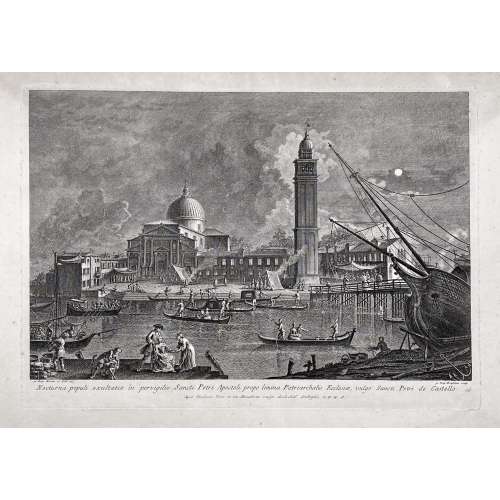
From the series of prints 'Prospectum Ædium Viarumque Insigniorum Urbis Venetiarum'. Inscribed below image left: "Jo. Bap. Moretti et Filii del. e Pinx."; right: "Jo. Baptista Brustoloni sculp."; in lower margin centre: "Nocturna populi exultatio in pervigilio Sancti Petri Apostoli prope limina Patriarchalis Ecclesiæ, vulgò Sancti Petri de Castello. / Apud Ludovicum Furlanetto supra Pontem vulgo dictum dei Baretteri C.P.E.S.". The third state, published by Teodoro Viero; the numbering on plate lower right, next to the inscription in Latin is cancelled as indicated by bibliography.
The subject is taken from a drawing by Giovanni Battista Moretti (Italian, active Venice, 1748-75) which in turn derives from a Canaletto painting. The print comes from the most important of Brustolon’s series, Prospectuum Aedium Viarumque Insignorum Urbis Venetiarum, dedicated to the Doge Marco Foscarini, from drawings by Canaletto, Moretti and sons and others, published for the first time by Ludovico Furlanetto in 1763 and later by Teodoro Viero. Giambattista Brustolon (1712–1796) was a famous Venetian engraver, a pupil of Joseph Wagner; whose talent is best displayed in his famous nocturnals: ‘riesce a dare il meglio di sé … nei famosi notturni’ (Succi).
Plate: 324 × 458 mm Sheet: 350 × 471 cm
References: The British Museum 1944,1014.209.48; The Metropolitan Museum of Art 60.611.29(4) (first state); Dario Succi, Da Carlevaris ai Tiepolo, 1983, pp.81-93, n. 55; William George Constable, J. G. Links, Canaletto: Giovanni Antonio Canal. 1697–1768. Oxford, 1989, vol. II, cat. no. 10, p. 674.
Condition: a very slight central fold, slight foxing and a very slight stain to the top, four small pinholes in corners, not affecting the engraving; else a well-margined copy in good condition.
-
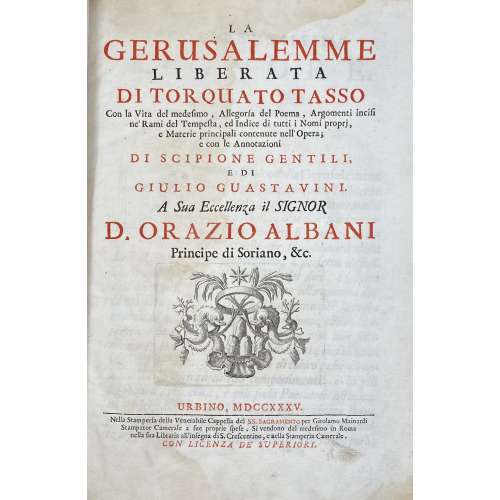 Title page (in red and black): LA | GERUSALEMME | LIBERATA | DI TORQUATO TASSO | Con la Vita del medesimo , Allegoria del Poema , Argomenti incisi | ne’Rami del Tempesta , ed Indice di tutti i Nomi proprj , | e Materie principali contenute nell’Opera ; | e con le Annotazioni | DI SCIPIONE GENTILI | E DI | GIULIO GUASTAVINI. | A Sua Eccellenza il SIGNOR | D. ORAZIO ALBANI | Principe di Soriano, &c. | {printer’s device} | URBINO, MDCCXXXV. | — | Nella Stamperia della Venerabile Cappella del SS. SAGRAMENTO per Girolamo Mainardi | Stampator Camerale a sue proprie spese . Si vendono dal medesimo in Roma | nella sua Libraria all’insegna di S. Crescentino, e nella Stamperia Camerale | CON LICENZA DE SUPERIORI. || Half-title: Title page: IL | GOFFREDO | OVVERO | LA GERUSALEMME | LIBERATA | DI | TORQUATO TASSO. || Collation: 4to; [2] blank leaves, [1] – h.t. / blank, [1] – t.p. / blank, [1] – dedication signed *2, [2] – vita, 1st signed *3, [2] – allegoria, [3] – indice, first two signed ** and **2, respectively, [1] – frontispiece to Canto Primo —> total 13 prelims; π13 (incl. 2 blanks), A-Z4 Aa-Bb4 Cc6 Dd-Qq4, χ1 (blank); 20 engraved frontispieces, one headpiece and initials, some historiated. Frontis. to Cantos II-XX incl. in collation and pagination; the number of leaves from A1 to Qq4 = 158; pagination: 1-316. The total number of leaves incl. prelims and blanks = 172. Note: three first leaves in the Cc quire of six leaves are signed; all other four-leaf quires only have the first two first leaves signed. Frontispiece to Canto Quarto cut down and laid down on D2v (as in Christie’s copy sold on 6 Jun 2010 – Live Auction 5475 – Fine Printed Books and Manuscripts, lot 168, price realized GBP 600). Illustrations: Frontispiece to Canto Primo signed “Arnoldo van Westerhout formis Roma”. Headpiece to Canto Primo signed “Eq. Petrus Leo Ghezius Inu. et. delin. — Frãn. Aquila incid.” Other plates unsigned but all attributed to Westerhout after Antonio Tempesta; Numeration of frontispieces in roman numbers, IIII for VI, VIIII for IX, XIIII for XIV, inverted numbers XVII, XVIII, and XIX, respectively: IIVX, IIIVX, and IIIIVX. Binding: 35 x 24 cm, 34 x 23 cm leaves, contemporary calf, rebacked retaining original spine, verso front flyleaf stamped “RESTORED BY MACDONALD CO. | NORWALK. CONN. Marbled endpapers, all edges red. Speckled calf, gilt triple-fillet borders, with remnants of blind-stamped and gilt design to an upper inside corner, spine with raised bands, gilt acorn tooling in compartments, later crimson label with gilt lettering. Damp staining to inside edges affecting all leaves. The Robin Collection bookplate to front pastedown. Provenance: The Robin Collection. Contributors: Torquato Tasso (Italian, 1544 –1595) – author. Scipione Gentili [Scipio Gentilis] (Italian, 1563 – 1616) Giulio Guastavini (Italian, fl. 16th century) Antonio Tempesta [Tempestino] (Italian, 1555 – 1630) – artist. Arnold [Arnoldo] van Westerhout (Flemish, 1651 – 1725) – artist, engraver. Pier Leone Ghezzi (Italian, 1674 – 1755) – artist. Francesco Faraone Aquila (Italian, c. 1676 – c. 1740) – engraver. Girolamo Mainardi (Italian, c. 1679 circa – 1763) – printer, publisher. Orazio Albani (Italian, 1576 – 1653) – dedicatee.
Title page (in red and black): LA | GERUSALEMME | LIBERATA | DI TORQUATO TASSO | Con la Vita del medesimo , Allegoria del Poema , Argomenti incisi | ne’Rami del Tempesta , ed Indice di tutti i Nomi proprj , | e Materie principali contenute nell’Opera ; | e con le Annotazioni | DI SCIPIONE GENTILI | E DI | GIULIO GUASTAVINI. | A Sua Eccellenza il SIGNOR | D. ORAZIO ALBANI | Principe di Soriano, &c. | {printer’s device} | URBINO, MDCCXXXV. | — | Nella Stamperia della Venerabile Cappella del SS. SAGRAMENTO per Girolamo Mainardi | Stampator Camerale a sue proprie spese . Si vendono dal medesimo in Roma | nella sua Libraria all’insegna di S. Crescentino, e nella Stamperia Camerale | CON LICENZA DE SUPERIORI. || Half-title: Title page: IL | GOFFREDO | OVVERO | LA GERUSALEMME | LIBERATA | DI | TORQUATO TASSO. || Collation: 4to; [2] blank leaves, [1] – h.t. / blank, [1] – t.p. / blank, [1] – dedication signed *2, [2] – vita, 1st signed *3, [2] – allegoria, [3] – indice, first two signed ** and **2, respectively, [1] – frontispiece to Canto Primo —> total 13 prelims; π13 (incl. 2 blanks), A-Z4 Aa-Bb4 Cc6 Dd-Qq4, χ1 (blank); 20 engraved frontispieces, one headpiece and initials, some historiated. Frontis. to Cantos II-XX incl. in collation and pagination; the number of leaves from A1 to Qq4 = 158; pagination: 1-316. The total number of leaves incl. prelims and blanks = 172. Note: three first leaves in the Cc quire of six leaves are signed; all other four-leaf quires only have the first two first leaves signed. Frontispiece to Canto Quarto cut down and laid down on D2v (as in Christie’s copy sold on 6 Jun 2010 – Live Auction 5475 – Fine Printed Books and Manuscripts, lot 168, price realized GBP 600). Illustrations: Frontispiece to Canto Primo signed “Arnoldo van Westerhout formis Roma”. Headpiece to Canto Primo signed “Eq. Petrus Leo Ghezius Inu. et. delin. — Frãn. Aquila incid.” Other plates unsigned but all attributed to Westerhout after Antonio Tempesta; Numeration of frontispieces in roman numbers, IIII for VI, VIIII for IX, XIIII for XIV, inverted numbers XVII, XVIII, and XIX, respectively: IIVX, IIIVX, and IIIIVX. Binding: 35 x 24 cm, 34 x 23 cm leaves, contemporary calf, rebacked retaining original spine, verso front flyleaf stamped “RESTORED BY MACDONALD CO. | NORWALK. CONN. Marbled endpapers, all edges red. Speckled calf, gilt triple-fillet borders, with remnants of blind-stamped and gilt design to an upper inside corner, spine with raised bands, gilt acorn tooling in compartments, later crimson label with gilt lettering. Damp staining to inside edges affecting all leaves. The Robin Collection bookplate to front pastedown. Provenance: The Robin Collection. Contributors: Torquato Tasso (Italian, 1544 –1595) – author. Scipione Gentili [Scipio Gentilis] (Italian, 1563 – 1616) Giulio Guastavini (Italian, fl. 16th century) Antonio Tempesta [Tempestino] (Italian, 1555 – 1630) – artist. Arnold [Arnoldo] van Westerhout (Flemish, 1651 – 1725) – artist, engraver. Pier Leone Ghezzi (Italian, 1674 – 1755) – artist. Francesco Faraone Aquila (Italian, c. 1676 – c. 1740) – engraver. Girolamo Mainardi (Italian, c. 1679 circa – 1763) – printer, publisher. Orazio Albani (Italian, 1576 – 1653) – dedicatee. -
 Ippitsusai Bunchō (一筆斎文調); lived 1725-1794; flourished 1755–1790. Size: Chuban; 26 x 20 cm The design presents a young woman reading a scroll while arranging her hear, and a young man with a rowing rod watching over her shoulder; the pair is standing on a giant shrimp that ferries them over a stream. The third passenger is a literate octopus, who's is attentively exploring the text of a scroll. This allusion comes to mind promptly: “Bodhidharma crossing the Yangzi River on a reed” (Royō Daruma).
Ippitsusai Bunchō (一筆斎文調); lived 1725-1794; flourished 1755–1790. Size: Chuban; 26 x 20 cm The design presents a young woman reading a scroll while arranging her hear, and a young man with a rowing rod watching over her shoulder; the pair is standing on a giant shrimp that ferries them over a stream. The third passenger is a literate octopus, who's is attentively exploring the text of a scroll. This allusion comes to mind promptly: “Bodhidharma crossing the Yangzi River on a reed” (Royō Daruma). Image from Asian Art Museum in San Francisco:
Image from Asian Art Museum in San Francisco:
Masanobu’s mitate wittily evokes an episode known as “Bodhidharma crossing the Yangzi River on a reed” (Royō Daruma). According to legend, the river crossing occurred en route to the Shaolin monastery, where Bodhidharma sat facing a wall for nine years without speaking. While serious interpretations abound in Chinese and Japanese paintings, popular prints of the Edo period often playfully substituted a beautiful woman for the monk. This parodic version was reportedly invented in response to a courtesan’s comment that she was more enlightened than Bodhidharma because she had spent ten years sitting, on display in a brothel.
An interesting article about this particular design is published at UKIYO-E.ORG BLOG. Though, the design is erroneously attributed to Harunobu. We see that Bunchō was quite fascinated by the idea of crossing a water obstacle with the help of an unsuitable means of transportation:
Female Daruma Riding a Mushroom. MFA # 21.4758.
-

Thin six-lobed iron plate of brownish color is carved on each side with a groove that follows the rim and a concentric grooves around the center of the plate, also carved with six thin scroll lines (mokkō or handles, kan) that follow the shape of the rim. Mokume surface treatment. Hitsu-ana possibly added at a later date, and kogai-hitsu-ana plugged with gold. Silver sekigane.
Signed: Kunihide [國秀]. Higo school, 1st generation swordsmith.
Mid Edo period, ca. 1800.
Would be possibly attributed to Kamakura-bori school revival of the 19th century.
References: Nihon Tō Kōza, Volume VI / Japanese Sword / Kodōgu Part 1, page 231: Enju Kunihide, a tōshō from Higo: "...forging of the jigane is excellent, and there are also pieces with mokume hada."
Haynes Index Vol. 1, p. 741, H 03569.0: "Enju Kunihide in Higo province, died 1830, student of Suishinshi Masahide. Retainer of the Hosokawa Daimyō, etc."
Additional Information from Markus Sesko: This tsuba indeed is made by Enju Kunihide, who in his later years signed the HIDE [秀] character as HI [日] and DE [出], as here: Size: 77.4 x 74.9 x 2.7 mm
Similar pieces are:
1. In this collection № TSU-0341: Kamakura-bori tsuba with mokkō motif. Muromachi period, 15th - 16th century.
2. Dr. Walter A. Compton Collection, 1992, Christie’s auction, Part II, pp. 14-15, №16: “A kamakurabori type tsuba, Muromachi period, circa 1400. The thin, six-lobed iron plate is carved on each side with a wide groove that follows the shape of the rim, and with six scroll lines and a single thin circular groove. […] The hitsu-ana was added at a later date, circa 1500-1550. Height 8.3 cm, width 8.6 cm, thickness 2.5 mm. The tsuba was initially intended to be mounted on a tachi of the battle type in use from Nambokucho to early Muromachi period (1333-1400)”. Sold at $935.
Size: 77.4 x 74.9 x 2.7 mm
Similar pieces are:
1. In this collection № TSU-0341: Kamakura-bori tsuba with mokkō motif. Muromachi period, 15th - 16th century.
2. Dr. Walter A. Compton Collection, 1992, Christie’s auction, Part II, pp. 14-15, №16: “A kamakurabori type tsuba, Muromachi period, circa 1400. The thin, six-lobed iron plate is carved on each side with a wide groove that follows the shape of the rim, and with six scroll lines and a single thin circular groove. […] The hitsu-ana was added at a later date, circa 1500-1550. Height 8.3 cm, width 8.6 cm, thickness 2.5 mm. The tsuba was initially intended to be mounted on a tachi of the battle type in use from Nambokucho to early Muromachi period (1333-1400)”. Sold at $935.
 3. And another one in Robert E. Haynes Catalog #9 on page 24-25 under №23: “Typical later Kamakura-bori style work. This type of plate and carving show the uniform work produced by several schools in the Muromachi </em period. Some had brass inlay and others were just carved as this one is. The hitsu are later. Ca. 1550. Ht. 8.8 cm, Th. 3.25 mm”. Sold for $175.
3. And another one in Robert E. Haynes Catalog #9 on page 24-25 under №23: “Typical later Kamakura-bori style work. This type of plate and carving show the uniform work produced by several schools in the Muromachi </em period. Some had brass inlay and others were just carved as this one is. The hitsu are later. Ca. 1550. Ht. 8.8 cm, Th. 3.25 mm”. Sold for $175.

-
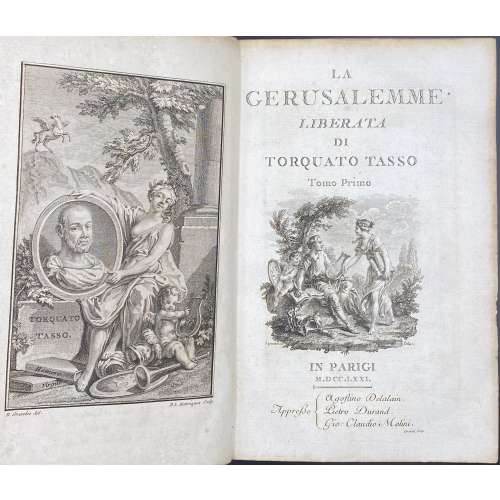 A two-volume set. Vol. 1:
A two-volume set. Vol. 1:Title: LA | GERUSALEMME | LIBERATA | DI | TORQUATO TASSO | Tomo Primo | {vignette} | IN PARIGI | M.DCC.LXXI | Appreßo { Agostino Delalain. | Pietro Durand. | Gio: Claudio Molini. | Droüet ∫crip.
Pagination: ffl [1] 2-331 [332] bfl; illustrations after Gravelot: frontis. by Henriquez, t.p. vignette by Patas, engraved dedication by Le Roy, 10 head- and 7 tailpieces by Le Roy, 5 full-page vignettes by Le Roy, and 10 plates by: Baquoy, Duclos (3), Le Roy, Lingée, Née, Rousseau, and Simonet (2).
Collation: 8vo; A-V8 X6.
Vol. 2: Title: LA | GERUSALEMME | LIBERATA | DI | TORQUATO TASSO | Tomo Secondo | {vignette} | IN PARIGI | M.DCC.LXXI | Appreßo { Agostino Delalain. | Pietro Durand. | Gio: Claudio Molini. | Droüet ∫crip. Pagination: ffl [1] 2-340 bfl; illustrations after Gravelot: frontis. by Henriquez, t.p. vignette by Mesnil, 10 head- and 6 tailpieces by Le Roy, 4 full-page vignettes by Le Roy, tailpiece by Ponce, and 10 plates by: Duclos, Henriquez, Leveau, Lingée, Massard, Née, Patas, Ponce, Rousseau, and Simonet. Collation: 8vo; A-X8 Y2. Size: 21.5 x 14.5 cm. Size of the copy sold at Sotheby's in 2015: 23.3 x 14.0 cm; Christie's in 2008: 23.2 x 14.4 cm Page size: 21 x 13.5 cm. In referenced sources, the page size is bigger than that. N. Ray gives 11 ½ x 8 7⁄8 inches or 9 x 5½ inches. Cohen and De Ricci do not bother to give sizes, considering that octavo is octavo. MFA: 30.3 x 23.1 x 4 cm (11 15/16 x 9 1/8 x 1 9/16 in.) Binding: Two volumes uniformly bound in full marbled calf, ruled in gilt, flat spine with gilt decorations and monogram, cream lettered label. Geoffrey Lord Cross of Chelsea [Geoffrey Cross, Baron Cross of Chelsea] (British, 1904 – 1989) bookplate to front pastedown. Catalogue raisonné: N. Ray №22, p. 48; Cohen De Ricci 974-975 According to MFA printing by: François-Augustin Quillau (French, 1743–1804). This edition was illustrated by Hubert François Gravelot (French, 1699–1773) and engraved by the following engravers: Jean Charles Baquoy (French, 1721–1777) Antoine Jean Duclos (French, 1742–1795) Benoît Louis Henriquez (French, 1732–1806) Jean Jacques André Le Veau (French, 1729–1785) Charles Louis Lingée (French, 1748–1819) Jacques Le Roy (French, born in 1739) Jean Massard (1740–1822) Elie du Mesnil (French, born about 1728) François Denis Née (French, 1735–1818) Charles Emmanuel Jean Baptiste Patas (French, 1744–1802) Nicholas Ponce (French, 1746–1831) Jean François Rousseau (French, born in 1740) Jean Baptiste Simonet (French, 1742–1813) Droüet (French, 18th century)


